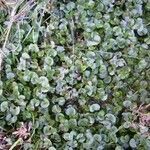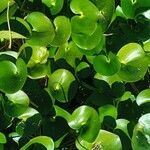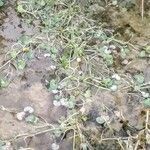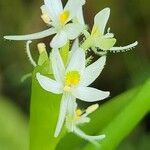Plants rooted, with elongate creeping stems. Leaves monomorphic with ex-panded reniform blade as large as 3 cm. long and 5 cm. broad; petiole extended. Spathe loosely ensheathing, caudate, 1-3 cm. long. Inflorescence short-spicate, 1-5 cm. long, 2-to 6-flowered. Flowers white or lavender, less than 2 cm. long, the tube less than 1 cm. long, usually about 0.7 cm. long; perianth lobes spread-ing, glandular-pubescent without; anterior sepal reflexed, very narrow; posterior petal somewhat expanded, green at base; stamens dimorphic, anterior longer, about 4 mm. long, posterior ones shorter, about 2 mm. long; larger anther oblong, green, about 1.5 mm. long, smaller ones globular, yellow, basifixed, about 0.5 mm. long; filaments dilated at their base, adnate to the perianth tube; style longer than the tube, about 7 mm. long above the ovary, with an expanded brush-like stigma facing upward and inward. Capsule about 1 cm. long; seed columnar, longitudinally ridged, 0.5-0.8 mm. long, 0.3-0.5 mm. broad.
Aerial lvs with floating or emersed, reniform blade 1–4 × 1–5 cm, as wide as or somewhat wider than long; petioles to 1.3 dm; spathe folded, 1–5 cm, loosely sheathingbelow; fls 2–8, all opening the same day, only the terminal one sometimes extending past the tip of the spathe; perianth largely white, densely glandular-pubescent outside, the tube 5–10 mm, the lobes 3–6.5 mm, 5 above and one below, the central upper one with 2 yellow (or green) spots at the base; filaments sparsely pubescent with spreading multicellular white hairs at least toward the tip; style pubescent with multicellular hairs; 2n=48. In shallow water or emersed on mud; Conn. and N.Y. to Mo., s. to trop. Amer.
Inflorescences 2-7-flowered. Flowers sessile. Tepals shorter than 1 cm. Perianth strongly zygomorphic, very distinctly gamophyllous, posterior segment with a discolorous blotch. Stamens 3; anthers basifixed. Filaments, at least those of the longer stamens, hairy.
A scrambling plant. The stems are long and branching. The leaves are kidney shaped and are about 2.5 cm across. The flowers occur in bunches and are pale blue.




